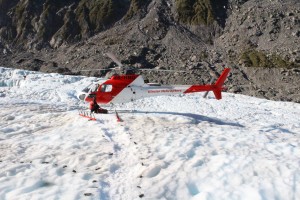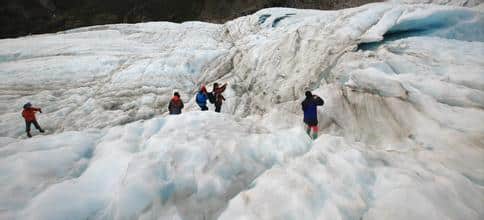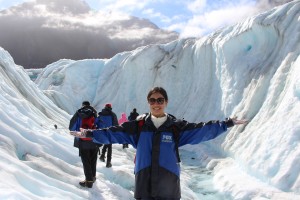
I have never thought I would stand on top of a massive piece of ice that is 200-meter thick and 13-kilometer long.
Well, Fox Glacier in New Zealand made what I thought to be impossible possible over the winter break. It even let me hike on it for 3 hours.
It is a world that seems to be lost in time: it’s miserably cloudy and rainy 200 days of a year, and I almost became one of those 60 percent tourists who had to leave with regret thanks to that foggy day (the helicopters that took us up to the glacier landing area had to fly below the cloud level for safety). Fortunately, I insisted on staying for another night after two unintended “glacier drills” (aka two unintended failure to land on the glacier) the first day: the first time – the fully-equipped me was called off the bus to the helicopter base after the weather briefing reported negative, and for the second time I almost stepped onto the helicopter before being dragged down again. Same reason.
However frustrating these two aborted missions were at the time, we finally got to doing what we paid for.
On this partly sunny day, not only did I wake up to much brighter skies, but I was also the first one in the 20-people group to finish gearing up, which included putting on thick socks, hiking boots, crampons (sharp treads tied to the shoes for grabbing hold of the ice), and waterproof pants and jacket. The 5-minute helicopter ride revealed the whole awe-inspiring glacier from the bottom to the top including an aged steeply slopping portion, a mildly gradient plain-like portion, and a top alpine ice-rock mixing region. Just as I was anxiously looking for a smooth piece of ice for our helicopter landing, it already landed itself safely right on the uneven ice surface. My first step on the ice reminded me of the one Armstrong took on the moon. It’s only that mine indicated a transition from the tropics to a frozen land, but his from the Earth to the Moon.
The air was so clean and fresh, and all of a sudden the strong light reflections coming from all the shiny white-blue ice dazzled my eyes. Sunglasses are definitely must-haves here, although they robbed some of the pleasures I had while zoning out staring at this pure land. Glacier ice is special ice because it is not water-ice but snow-ice, formed by the accumulation and compaction of snow over a long period of time. According to our guide, Fox Glacier is a relic from the last Ice Age (110,000 to 10,000 years ago), and together with its neighbor Franz Josef Glacier, one in Alaska, and one in South America, are four of the largest moving glaciers in the world.
Fox Glacier and Franz Josef Glacier are particularly special and rare because they are sitting so close to the coast. They call it a moving glacier because the flat part of Fox Glacier is moving down at the speed of 1 meter every day while the steep part is moving 3 meters per day towards the coast due to the melting at the bottom. That is really wildly super fast!
That is why we are seeing a 100-meter glacier retreat every year and an 80-meter vertical decline since 2008. While all those numbers made me a lucky dog to still be allowed on this natural marvel, I inevitably felt sorry for disturbing its peace.
Our guide led the way by using his huge axe to cut away some fragile ice and carve out some footsteps for us to follow, and those steps may be the only things that were artificial on the glacier.
Over the 3 hours hiking, we were taken through some amazing naturally formed shapes and patterns: crevasses (crack), ice caves, moulin (glacier mill), moraines (rock deposit), and ice falls. We were also led into a cave where the gap between two ice walls was so narrow that only one person was allowed at a time. I had to hold my breath and lean my back against the wall to fit through the squeeze, and move only one tiny step at a time to prevent myself from falling into the rushing ice stream. But there were more to keep us busy: we had to concentrate on our foot placements, watch out for ice holes so as not to fall in, take tons of pictures and keep our cameras dry, kneel down frequently to prevent being blown away by helicopters, and keep every part of our bodies from freezing. I could feel that the glacier was hissing in the heat of the sun and growling at us the little monsters who kept jamming crampons into its surface.
As exhausted as I was on my helicopter ride back, I was left exhilarated all over. This was my first time on a glacier, but in no way I hope it’s the last. I held tightly my water bottle that contained a small piece of ice from the glacier and stared into it. It’s so pure.



